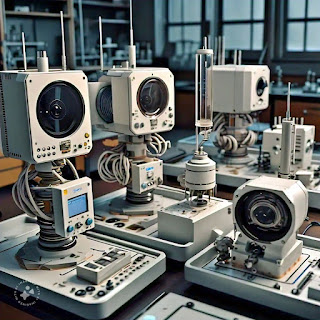Understanding X-ray Detector Components: A Comprehensive Guide
X-ray detectors are integral to modern medical imaging, offering precise diagnostics and playing a crucial role in various medical fields. To appreciate their importance, it's essential to understand the components that make up these sophisticated devices. In this blog, we'll delve into the key components of X-ray detectors and explore their functions and significance.
1. Scintillator: The Light Converter
The scintillator is one of the most critical components of
an X-ray detector. Its primary function is to convert incoming X-ray photons
into visible light. This conversion is crucial because the subsequent
components of the detector are more sensitive to light than to X-rays.
Scintillators are typically made of materials like cesium iodide (CsI) or
gadolinium oxysulfide (GOS), chosen for their efficiency in converting X-rays
to light with minimal loss of energy.
2. Photodiode Array: Capturing the Light
Once the scintillator converts X-rays into visible light,
the photodiode array steps in. This component is responsible for converting the
light into an electrical signal. Photodiodes are semiconductor devices that
generate a current when exposed to light, with the magnitude of the current
proportional to the intensity of the light received. The photodiode array is
carefully designed to match the scintillator’s output, ensuring that the
maximum amount of light is captured and converted into an accurate electrical
signal.
3. Thin-Film Transistor (TFT) Array: Signal Control and
Readout
The Thin-Film Transistor (TFT) array is another crucial
component in X-ray detectors, particularly in flat-panel detectors. The TFT
array acts as a switch, controlling the readout of the electrical signals
generated by the photodiodes. It organizes the signals into a readable format,
which is then transmitted to the processing system. The precision of the TFT
array directly influences the quality and resolution of the final X-ray image.
4. Analog-to-Digital Converter (ADC): Digital
Transformation
The Analog-to-Digital Converter (ADC) is responsible for
transforming the continuous electrical signals from the photodiode array into
digital data. This data is then processed and displayed as an X-ray image on a
screen. The ADC’s resolution is crucial; higher resolution converters produce
more detailed images, which are essential for accurate diagnosis.
5. Signal Processing Unit: Enhancing the Image
The signal processing unit is where the raw digital data is
refined into a clear and precise X-ray image. This component uses various
algorithms to enhance the image quality, adjusting contrast, brightness, and
filtering out noise. Advanced signal processing can also assist in highlighting
specific areas of interest within the image, making it easier for radiologists
to identify abnormalities.
6. Housing and Shielding: Protecting the Detector
The housing and shielding of an X-ray detector are often
overlooked but are vital for the device’s functionality and longevity. The
housing protects the internal components from physical damage and environmental
factors, while the shielding prevents unwanted radiation exposure to both the
components and the medical staff. This component ensures that the detector
operates safely and effectively over an extended period.
Conclusion
Understanding the components of X-ray detectors provides
insight into how these devices work and their significance in medical
diagnostics. Each component, from the scintillator to the signal processing
unit, plays a crucial role in ensuring the production of high-quality X-ray
images. As technology continues to evolve, advancements in these components
will lead to even more precise and reliable imaging solutions, ultimately
improving patient care and outcomes.
By staying informed about the intricacies of X-ray detector
components, healthcare professionals and technicians can better appreciate the
technology that aids them in delivering accurate diagnoses and treatments.
Content
Source:
https://www.marketsandmarkets.com/PressReleases/x-ray-detectors.asp
https://www.marketsandmarkets.com/ResearchInsight/x-ray-detectors-market.asp

Comments
Post a Comment